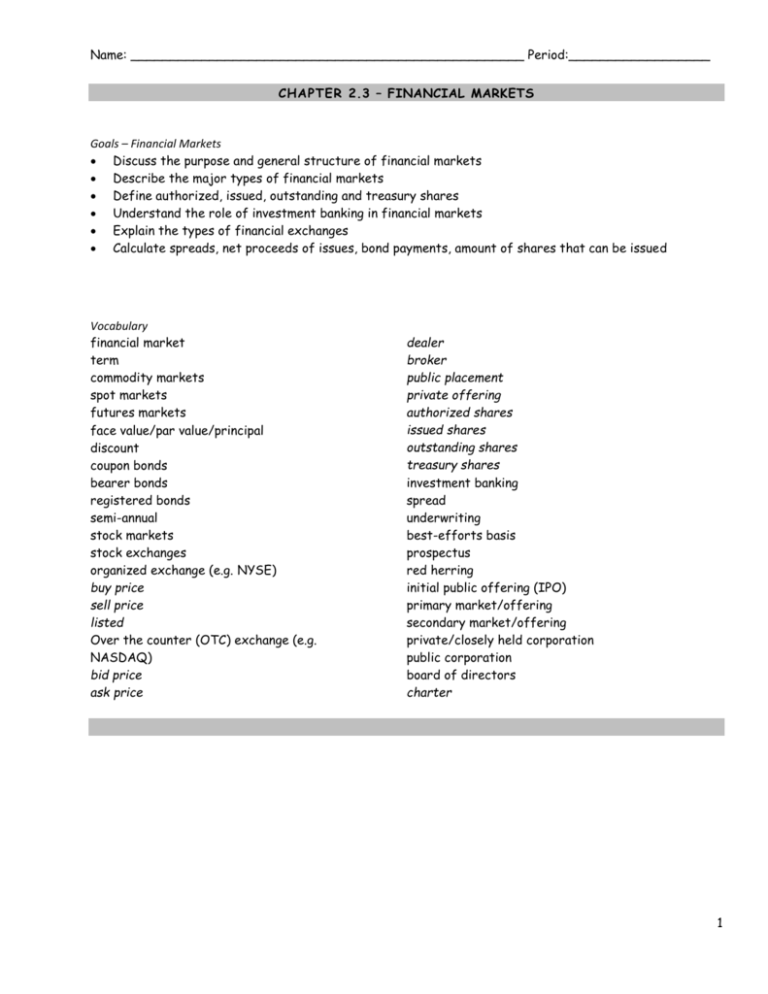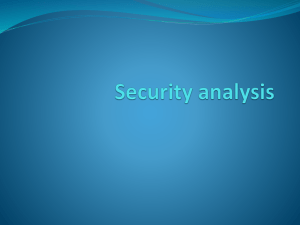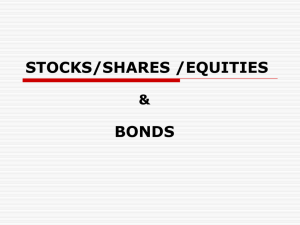Financial Markets: Worksheet & Study Guide
advertisement

Name: __________________________________________________ Period:__________________ CHAPTER 2.3 – FINANCIAL MARKETS Goals – Financial Markets Discuss the purpose and general structure of financial markets Describe the major types of financial markets Define authorized, issued, outstanding and treasury shares Understand the role of investment banking in financial markets Explain the types of financial exchanges Calculate spreads, net proceeds of issues, bond payments, amount of shares that can be issued Vocabulary financial market term commodity markets spot markets futures markets face value/par value/principal discount coupon bonds bearer bonds registered bonds semi-annual stock markets stock exchanges organized exchange (e.g. NYSE) buy price sell price listed Over the counter (OTC) exchange (e.g. NASDAQ) bid price ask price dealer broker public placement private offering authorized shares issued shares outstanding shares treasury shares investment banking spread underwriting best-efforts basis prospectus red herring initial public offering (IPO) primary market/offering secondary market/offering private/closely held corporation public corporation board of directors charter 1 SECTION 2.3 TYPES OF FINANCIAL MARKETS 1. A financial market provides an organized process for the exchange of money. Businesses and governments use the money to obtain ____________________ to operate the business or provide services. Consumers use the money to fill ______________________. When deciding which market to invest in, investors consider __________, __________________ and the ___________ of the investment. Each market helps to set the supply and demand for a specific investment, thereby setting the ____________. 2. Shares of stock that a company can sell are known as __________________________ shares. The number of shares of stock a company can sell is listed in the company _____________________. Stocks that have been sold in the marketplace are known as ___________________ shares. Issued shares held by investors are called ____________________________ shares. Sometimes the company issuing the stock buys some of its own shares back. These shares then become __________________________ stock and are no longer considered to be outstanding. 3. When a company decides to offer securities they can choose between a private placement and a public offering. With a ________________________________, the company knows exactly who will purchase the security when it goes to market. This type of offering is most common with small companies that are owned by a small number of people. These types are companies are known as _______________________ or ___________________ corporations. Large companies may also use a private placement when the security is purchased by an ________________________ investor such as a mutual fund. The sale of securities to the general public is known as a _________________ offering. When a company issues stock for the very first time ever it’s called the company’s ____________________________________ or _________. If the company decides to issue more of its authorized shares at a later date, those shares are known as the company’s _______________________ offering. Public offerings often bring in _______________ money, but they are __________ expensive than private offerings. 2 IPO Process 1. Consult an investment banker 2. Obtain necessay approvals 3. Notify the public of issue •underwriting •stockholders •prospectus •best-efforts •SEC Registration •red herring 4. When a security is issued for the first time, 4. Sell the issues at the issue price Underwriting Calculation it is sold in the _____________________ Issue Price market. The primary market is the place - Administrative Fees where both __________________ and - Selling Costs _____________________ offerings are - Sales Commission sold. Once a share is issued, it can then be - Required Profit traded by the public in the = Net Proceeds __________________ market. 5. The __________________________ market is used to trade raw materials and other basic production resources. Spot markets buy and sell commodities for ________________________ delivery. Futures markets negotiate ___________________ to buy and sell commodities at a ______________ date. Futures markets help protect against the __________ of uncertain markets. 6. Bond markets trade _________ securities issued by ____________________ and ___________________. Bonds in the United States are issued with face amounts, or ________ values, of __________________. Some bonds earn interest which is payable to the _____________________ every ____ months. These types of bonds are called _______________ bonds. Bonds that do not earn interest are called _________________________ bonds. These bonds are issued at a _______________________ which means they are sold for less than the par value, or _________ amount. In the past, bond payments were made to whoever had physical possession on the bond. These types of bonds are called ______________ bonds. Because these bonds could be easily stolen, the SEC now requires bonds to be _______________________ in a computer which keeps track of the owner of the bond. Payments are then made to the registered owner. 3 7. Securities _________________________________ provide the marketplace for the sale and purchase of securities. ____________________________________ exchanges are formal organizations with ________________ locations. They act as secondary markets for securities by holding ____________. The goal of trading is to fill ________ orders at the lowest price and _________ orders at the highest price. These exchanges own the rights to trade the stocks of _____________ companies. The largest organized exchange in the U.S. is the _____________________________________________. Other major organized exchanges include the ____________ (American Stock Exchange), regional exchanges in _______________________, __________________, ______________________ and _______________________ and international exchanges in _____________, _____________, __________________, ____________________________, _______________________, ________________________ and _____________________. 8. An over-the-counter, or ________, exchange is used to trade securities that are not ____________ on any of the organized exchanges. These markets do not have a ____________________ location. Trades in this market are made by a collection of _______________ who hold _______________________ of OTC securities. Thousands of ___________________ act as agents in bringing together the dealers and potential investors. Telephones and computers are used to continuously communicate the dealer’s current ______________ price (price at which the dealer will purchase securities) and the dealer’s ___________ price (the price at which the dealer will sell securities). The largest OTC market in the U.S. is the National Association of Securities Dealers Automated Quotation, or ___________________. 4 SECTION 2.3 REVIEW QUESTIONS 1. 2. 3. 4. 5. 6. 7. 8. 9. 10. 11. 12. 13. 14. 15. 16. Why are financial markets important to firms and investors? What are (a) initial public offerings and (b) secondary offerings? Distinguish between public offerings and private placements. What functions does an investment banker perform? Explain the sequence of events in the issuing of a new security? How are underwriting costs affected by the size and type of an issue? What is the purpose of a prospectus? Hildreth Recycling is interested in selling common stock to raise capital for a plant expansion. The firm has hired First Atlanta Company, a large investment banking firm, to serve as underwriter. First Atlanta believes that the stock can be sold for $80 per share, that its administrative costs will be 2% of the sale price, and that its selling costs will be 1.5% of the sale price. If First Atlanta requires a profit equal to 1% of the sale price, how much will the spread have to be, in dollars, to cover its costs and profits? RM International wishes to sell $100 million of bonds whose net proceeds will be used in the acquisition of Little Books. The company has estimated that the net proceeds, after paying underwriting costs, should provide an amount sufficient to make the acquisition. The underwriter believes that the 100,000 bonds can be sold to the public for par and estimates that its administrative costs will be $4.25 million. The underwriting commission (in addition to recovery of its administrative costs) is 1% of the par value of the offering. a. Calculate the per bond spread required by the underwriter to cover its costs. b. How much money will RM International net from the issue? c. How much will the underwriter receive from the issue? d. Assuming that this is a public offering, describe the nature of the underwriter’s risk. Why are secondary markets important? Charter Corp. has issued 2,500 bonds with a total value of $2,500,000. The bonds have a 7%coupon rate. a. What dollar amount of interest per bond can an investor expect to receive every six months from Charter Corp.? b. What is Charter’s total interest expense per year associated with these bonds? Aspin Corporation’s charter authorizes issuance of 2,000,000 shares of common stock. Currently, 1,400,000 shares are outstanding and 100,000 shares are being held as treasury stock. The firm wishes to raise $48,000,000 for a plant expansion. Discussions with its investment bankers indicate that the sale of new common stock will net the firm $60 per share. a. What is the maximum number of new shares of common stock the firm can sell without receiving further authorization from shareholders? b. Based on the data given and your finding in part a, will the firm be able to raise the needed funds without receiving further authorization? c. What must the firm do to obtain authorization to the number of shares needed? Why might the financial manager of a company buy its own shares? Why might the manager sell the treasury shares? Compare and contrast organized exchanges with OTC exchanges. What are bid prices and ask prices? Why are prices in the OTC quoted in this way? Answer the following questions from your textbook: a. Page 40 - Questions 4, 5 b. Page 45 – Checkpoint question c. Page 47 – Questions 1, 2, 4, 5 d. Page 52 – Questions 1, 2, 3, 4, 5 e. Page 57 – Questions 1, 3, 4 f. Pages 59 to 62 – Questions 11, 12, 13, 17, 20, 21, 22, 23, Stock Market Activity 1, 2, 3 5







